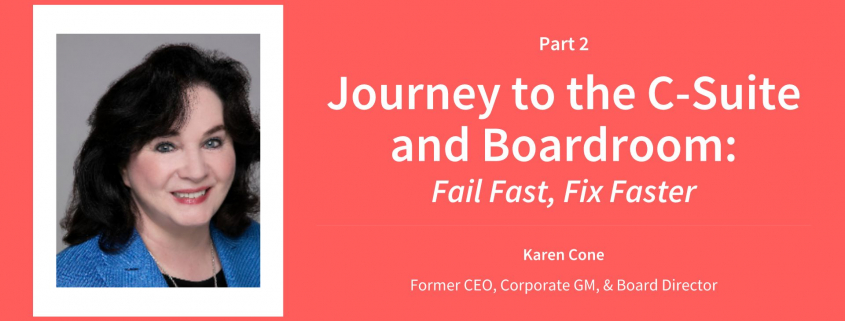After almost 20 years at IBM, I accepted an opportunity with Gartner, the leading IT advisory research firm. With a clean slate, I moved rapidly from a research director position to senior vice president and general manager, reporting to the CEO. Of course there were bumps along the way. I expect you have heard of the “fail fast” approach. Well, I have lived “fail fast” and determined that one also needs to “fix faster.”
“Fail fast, fail often” became a Silicon Valley mantra for start-ups at the height of the dot-com era. Today, as we constantly stretch the edges of the digital world and the boundaries between digital and “brick and mortar” are blurring, “fail fast” has expanded from the start-up world into established businesses. But the business leader who executes on “fail fast” and succeeds in failing is often at risk. Ken Spencer, an innovation thought leader and CEO of Spyder Works wrote an article headlined: “‘Fail fast, fail often’ may be the stupidest business mantra of all time.” Can one “fail fast” without career failure?
The “monkey” is on my back
It was at the turn of the 21st century and e-commerce, dot-com, and the Y2K “bug” were all featured in Gartner research. I was head of Gartner’s technology and IT management research services; we were predicting the explosion of the internet and advising clients on the growing importance of the Web to their businesses and the need to be a player in the rapidly emerging digital world. At senior leadership team meetings, I frequently brought up the widening gap between our research and our limited web reality, and its impact on our credibility with clients.
I must have been too vocal, because the CEO called me in and told me that I was now the General Manager of gartner.com and the problem was mine to fix..
I was blindsided—this was not expected. Like most business and technology leaders at this time, I had no internet experience. My CEO explained that an inside person was needed to lead the effort, someone who knows the business and who the Heads of the disparate acquisitions would trust to also take care of their interests. Apparently that inside person was me. So I took a deep breath and started pulling a team together.
We held multiple focus groups both with clients and non-clients who told us what they “hated” about the current gartner.com and research distribution, and shared their visions for the future of our product. This included a website that had contextual search capabilities to filter through the thousands of possibilities and return highly relevant results. We set to work designing a totally unique look and feel for the new gartner.com with ground-breaking functionality.
At Gartner all-company meetings, we promised a new website that would “seduce, sizzle, and stick”. Everyone loved it. I presented the approach to clients at the Gartner Symposium. When I closed my pitch with the words, “We will launch a website that gives you what you never knew you wanted but can’t live without,” I got a standing ovation. My team and I were convinced we had a winner. We were under great pressure from clients, senior management, and the board to launch. So we moved rapidly to get the lightly field-tested product to market.
Learning the hard way
We launched a leading-edge website in January 2001. We gave our clients just what they asked for. And it bombed—badly! We quickly learned the meaning of the phrase—“give your customers what they ask for, but not too much.”
Usually, this means, “Don’t let your customers drag you down into the traditional and miss the next breakthrough innovation.” In our case, it meant our clients (customers) were not ready for the magnitude of change the new web interface introduced. We began to realize that our testing was focused on ideas rather than actual user experience. Additionally, we discovered that the excellent relevance of results did not compensate for the fact that the search engine was slow. In the Web world, response time is non-negotiable. I had failed and done it fast! Now we needed to fix it fast!
“I can do that…”
Thankfully, even when we felt our most confident, we put a contingency plan in place. Prior to the original launch, we were optimistic the new website was what our clients were asking for—yet we also knew that we might need to adapt quickly.
From the start, we held all-team meetings every week. During these meetings, we would challenge the team to brainstorm solutions to our most difficult requirements, the potential showstoppers. My favorite words to hear were when someone would call out: “I can do that…” So once again, we called the team together and explained what we needed to fix fast! This included “dumbing down” the user interface and changing it to something much more familiar. However, the far more complicated challenge was to significantly reduce the response time of the search engine, while keeping relevance.
As soon as we presented the problem, conversations spread throughout the large room. The team was thinking out loud. They owned the challenge. We waited… And then we heard the magic words, “I can do that…” And we did. We embraced our failure, learned from it, and moved on to focus on the fix. Three months later, in April 2001, we launched the second version of gartner.com. And it was a great success.
I surely prefer success, yet I must admit I did learn life-changing lessons from failure. Some are specific to this scenario, like the incredible risks associated with short-cutting critical success factors, such as user experience. Or, the fact that the “best” solution may not be the right solution. Or, listening to your customers, but not too much. More profoundly, I recognized that if one looks to survive a “Fail Fast” risk, having the Team and key Stakeholders with you is essential to “Fix Faster.”
Karen Cone FORMER CEO, CORPORATE GM, & BOARD DIRECTOR
Karen Cone is the former Microsoft General Manager, Worldwide Financial Services Sector, and CEO and Board Director of the advisory research firm, TowerGroup. She currently serves on multiple advisory boards and is a venture partner for the MastersFund, focused on women founders in technology. Karen has also held senior executive positions with increasing responsibility and scope at IBM, MasterCard and Gartner, where she served on the Gartner International Board. She has lived and worked in the Americas, EMEA & Asia. Karen and her husband, Jeff, have three sons and four grandchildren and currently live in Seattle, Washington.




